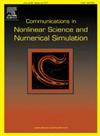一类具有lsamvy噪声的退化随机动力系统的过渡路径
IF 3.8
2区 数学
Q1 MATHEMATICS, APPLIED
Communications in Nonlinear Science and Numerical Simulation
Pub Date : 2025-06-13
DOI:10.1016/j.cnsns.2025.109034
引用次数: 0
摘要
本文研究了一类具有(非高斯)lsamvy噪声和brown噪声的退化随机动力系统的Onsager-Machlup函数。这是基于Girsanov变换,然后通过路径表示得到的。此外,这个Onsager-Machlup函数可以看作是给出最可能跃迁路径的拉格朗日函数。Hamilton-Pontryagin原理对于处理退化情况下的变分问题是必不可少的。最后,对噪声简并的动力学朗之万系统进行了具体的分析和数值研究。本文章由计算机程序翻译,如有差异,请以英文原文为准。
Transition pathways for a class of degenerate stochastic dynamical systems with Lévy noise
This work is devoted to deriving the Onsager–Machlup function for a class of degenerate stochastic dynamical systems with (non-Gaussian) Lévy noise as well as Brownian noise. This is obtained based on the Girsanov transformation and then by a path representation. Moreover, this Onsager–Machlup function may be regarded as a Lagrangian giving the most probable transition pathways. The Hamilton–Pontryagin principle is essential to handle such a variational problem in the degenerate case. Finally, a kinetic Langevin system in which noise is degenerate is specifically investigated analytically and numerically.
求助全文
通过发布文献求助,成功后即可免费获取论文全文。
去求助
来源期刊

Communications in Nonlinear Science and Numerical Simulation
MATHEMATICS, APPLIED-MATHEMATICS, INTERDISCIPLINARY APPLICATIONS
CiteScore
6.80
自引率
7.70%
发文量
378
审稿时长
78 days
期刊介绍:
The journal publishes original research findings on experimental observation, mathematical modeling, theoretical analysis and numerical simulation, for more accurate description, better prediction or novel application, of nonlinear phenomena in science and engineering. It offers a venue for researchers to make rapid exchange of ideas and techniques in nonlinear science and complexity.
The submission of manuscripts with cross-disciplinary approaches in nonlinear science and complexity is particularly encouraged.
Topics of interest:
Nonlinear differential or delay equations, Lie group analysis and asymptotic methods, Discontinuous systems, Fractals, Fractional calculus and dynamics, Nonlinear effects in quantum mechanics, Nonlinear stochastic processes, Experimental nonlinear science, Time-series and signal analysis, Computational methods and simulations in nonlinear science and engineering, Control of dynamical systems, Synchronization, Lyapunov analysis, High-dimensional chaos and turbulence, Chaos in Hamiltonian systems, Integrable systems and solitons, Collective behavior in many-body systems, Biological physics and networks, Nonlinear mechanical systems, Complex systems and complexity.
No length limitation for contributions is set, but only concisely written manuscripts are published. Brief papers are published on the basis of Rapid Communications. Discussions of previously published papers are welcome.
 求助内容:
求助内容: 应助结果提醒方式:
应助结果提醒方式:


